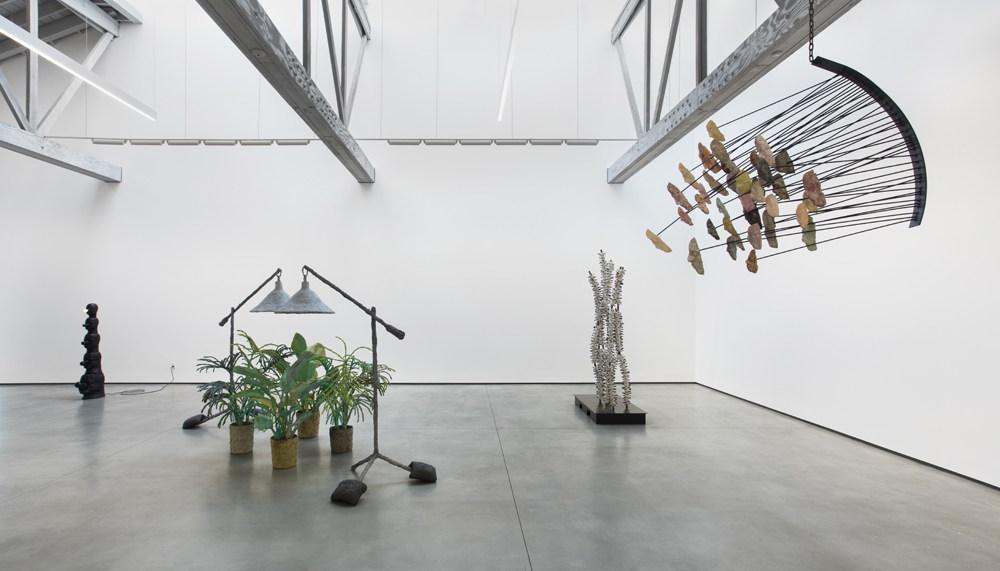Evan Holloway
David Kordansky Gallery, Los Angeles, USA
David Kordansky Gallery, Los Angeles, USA

When I learned that Evan Holloway’s recent solo exhibition at David Kordansky was his first in Los Angeles in almost 12 years, I found it hard to believe. Ever since I first saw his tragicomic 1998 sculpture Left Handed Guitarist – a polystyrene grunge rocker bent over a crude graphite drawing of an infinitely receding psychedelic wormhole – I’ve always thought of his work as a material element of that city. Work that folds imagery from counterculture history into serious sculptural exploration. I imagined that each time I visited Los Angeles, there would be a Holloway exhibition somewhere. It might be in a gallery or a museum, or in a seminar room at CalArts. But, more likely, it would be in a basement rehearsal space, moonlighting as a sidewalk sign for a health food store, hiding in the back of a decrepit van parked by the beach in Venice, surrounded by mandalas in a geodesic dome or alone in the desert waiting for aliens or dead-eyed hipsters on peyote to stumble across it. Clichés, every one of them – because Holloway’s sculptures successfully traffic not just in inventive materials, but in droll commentary on California’s pop imaginary.

For instance, take Benzoin (2015), one of six sculptures in the David Kordansky show: a large, freestanding fibreglass Möbius strip, the grey surface of which has an unfinished texture. Think hungover Henry Moore or garage band M.C. Escher – a sculpture waiting to be cast in something classier, like bronze or aluminium. Then you notice the sweet smell and thin plume of smoke rising from its base and realize Benzoin is an overgrown incense burner. The punchline is funny, the effect multilayered. There’s a game of scale being played here – of a physically imposing object being used to cradle something light and delicate – and, at the same time, a game of use value. Benzoin has fun with the mystic mathematics of the modern: abstraction not as a formal enquiry but as a rollercoaster ride into inner space. It could be a monument for the tranquil gardens of a New Age cult HQ.

Lamp (2016) is also head-expanding, literally so. A totem of five stacked heads grow in size, with the smallest at the top. Holloway sculpted them in Hydrospan, an expanding polymer resin, and then cast each successive head in bronze from the last, so they grow in size and grotesque detail. Instead of a nose, each gargoyle sports a bronze lightbulb, apart from the top head, which has a working light. Is Lamp functional, as its title suggests? To my mind, it’s an illustrated warning: the deeper you voyage into mind-expansion in pursuit of illumination, the heavier and uglier things get. Or – if we are to take lessons from the phalanx of gaunt faces that float down on us from the ceiling sculpture In the Column (2015) – freeing your mind may leave you forever untethered from reality. This danger might also course through Serpent and Lightning (2016), one of Holloway’s signature ‘tree’ pieces: dead branches cast in bronze and constructed into roughly geometric growths. Its coloured twigs and limbs look like internal wiring extracted from a house, or the schematic diagram of a nervous system. The growth of this tree appears controlled, cultivated with aesthetic cruelty: the Tree of Knowledge (as the serpent reference in the title hints) electrified stiff by lightning. In that sense, Holloway’s show describes forms of failed cultivation or dissipated energy. Landscape (2015) presents us with plaster and steel cacti; they look bleached to death by desert sun or radiation, their spines made from spent batteries. Bang in the middle of the gallery sits Plants and Lamps (2015), roughly hewn hydroponic lamps shining neither light nor warmth onto ferns and forlorn potted plants. In Holloway’s world, nothing grows; it is only synthesized. This is nature art for the climate-change apocalypse.
For all that bleakness, Holloway’s work retains a strong handmade quality. Proudly analogue, its D.I.Y. ethic reflects the spirit of self-sufficiency through material experimentation. And in that sense, his work carries a positive message of self-discovery. What could be more Californian than that?

























